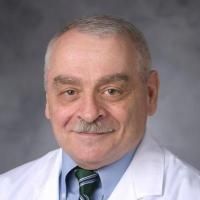The CO/HO system reverses inhibition of mitochondrial biogenesis and prevents murine doxorubicin cardiomyopathy.
Date
2007-12
Journal Title
Journal ISSN
Volume Title
Repository Usage Stats
views
downloads
Citation Stats
Attention Stats
Abstract
The clinical utility of anthracycline anticancer agents, especially doxorubicin, is limited by a progressive toxic cardiomyopathy linked to mitochondrial damage and cardiomyocyte apoptosis. Here we demonstrate that the post-doxorubicin mouse heart fails to upregulate the nuclear program for mitochondrial biogenesis and its associated intrinsic antiapoptosis proteins, leading to severe mitochondrial DNA (mtDNA) depletion, sarcomere destruction, apoptosis, necrosis, and excessive wall stress and fibrosis. Furthermore, we exploited recent evidence that mitochondrial biogenesis is regulated by the CO/heme oxygenase (CO/HO) system to ameliorate doxorubicin cardiomyopathy in mice. We found that the myocardial pathology was averted by periodic CO inhalation, which restored mitochondrial biogenesis and circumvented intrinsic apoptosis through caspase-3 and apoptosis-inducing factor. Moreover, CO simultaneously reversed doxorubicin-induced loss of DNA binding by GATA-4 and restored critical sarcomeric proteins. In isolated rat cardiac cells, HO-1 enzyme overexpression prevented doxorubicin-induced mtDNA depletion and apoptosis via activation of Akt1/PKB and guanylate cyclase, while HO-1 gene silencing exacerbated doxorubicin-induced mtDNA depletion and apoptosis. Thus doxorubicin disrupts cardiac mitochondrial biogenesis, which promotes intrinsic apoptosis, while CO/HO promotes mitochondrial biogenesis and opposes apoptosis, forestalling fibrosis and cardiomyopathy. These findings imply that the therapeutic index of anthracycline cancer chemotherapeutics can be improved by the protection of cardiac mitochondrial biogenesis.
Type
Department
Description
Provenance
Subjects
Citation
Permalink
Published Version (Please cite this version)
Publication Info
Suliman, Hagir B, Martha Sue Carraway, Abdelwahid S Ali, Chrystal M Reynolds, Karen E Welty-Wolf and Claude A Piantadosi (2007). The CO/HO system reverses inhibition of mitochondrial biogenesis and prevents murine doxorubicin cardiomyopathy. J Clin Invest, 117(12). pp. 3730–3741. 10.1172/JCI32967 Retrieved from https://hdl.handle.net/10161/13989.
This is constructed from limited available data and may be imprecise. To cite this article, please review & use the official citation provided by the journal.
Collections
Scholars@Duke

Karen Elizabeth Welty-Wolf
Dr. Welty-Wolf studies (1) pathophysiology and treatment of acute lung injury and (2) multiple organ failure and disordered energy metabolism in sepsis. Injury models include hyperoxic lung injury and ARDS with multiple organ failure due to sepsis. In addition to evaluating mechanisms of lung injury in sepsis, current studies are being conducted to evaluate the potential role of monoclinal antibodies to neutrophil adhesion molecules in the prevention of this injury. Other sepsis work includes evaluating mechanisms of oxidative damage to mitochondria. Additional research efforts include evaluating the use of human recombinant manganese superoxide dismutase in preventing hyperoxic lung injury.

Claude Anthony Piantadosi
Dr. Piantadosi's laboratory has special expertise in the pathogenic mechanisms of acute organ failure, particularly acute lung injury (ALI), with an emphasis on the molecular regulatory roles of the physiological gases— oxygen, carbon monoxide, and nitric oxide— as they relate to the damage responses to acute inflammation. The basic science focuses on oxidative processes and redox-regulation, especially the molecular mechanisms by which reactive oxygen and nitrogen species transmit biological signals involved in the maintenance of energy metabolism and mitochondrial health, but also contribute to pathogenesis and to the resolution of tissue injury.
Clinically, ALI and the related syndrome of multiple organ failure has a high mortality, which is related to the host inflammatory response, but is not well understood scientifically; thus, the laboratory is devoted to understanding these mechanisms in the context of the host response to relevant but well-controlled experimental manipulations including hyperoxia, bacterial infections, toxic drugs, and cytokine/chemokine signals. The approach relies on animal models, mainly transgenic and knockout mice, and cell models, especially lung and heart cells to evaluate and understand the physiology, pathology, and cell and molecular biology of the injury responses, to test independent and integrated mechanisms, and to devise interventions to prevent damage.
Apart from the lung, significant work is devoted to understanding damage to the heart, brain, liver, and kidney caused by these immune mechanisms, specifically emphasizing the role of mitochondria, key targets and sources of oxidative damage. This damage compromises their ability to support energy homeostasis and advanced cellular functions, and impacts on the important roles these organelles play in cell death by apoptosis and necrosis as well as in the resolution of cellular damage and inflammation.
Unless otherwise indicated, scholarly articles published by Duke faculty members are made available here with a CC-BY-NC (Creative Commons Attribution Non-Commercial) license, as enabled by the Duke Open Access Policy. If you wish to use the materials in ways not already permitted under CC-BY-NC, please consult the copyright owner. Other materials are made available here through the author’s grant of a non-exclusive license to make their work openly accessible.
